» Site Navigation

1 members and 1,597 guests
Most users ever online was 6,337, 01-24-2020 at 04:30 AM.
» Today's Birthdays

» Stats

Members: 75,473
Threads: 248,810
Posts: 2,570,461
Top Poster: JLC (31,651)
|
-
A Lesson in Basic Genetics
Layman’s Crash Course in Ball Python Genetics
This explanation is not meant to be taken as a scientific study or anything like that. It is written from a layman's point of view in order to offer a basic understanding of how genetics work in Ball Python breeding and the various genetic terms as they are commonly used in the BP community. Hopefully the visuals created for this lesson will provide a solid foundation for future learning.
GLOSSARY OF TERMS
Allele – A pair of genes at the same location on the DNA strand
Co-Dominant – A visible mutation appears when a single gene at an allele is different than normal. A matched pair of this gene brings about a “super” form that looks different than the single.
DNA -- Part of the genetic code that makes up all living things.
Dominant – A visible mutation appears when a single gene at an allele is different than normal. However, there is no known “super” form of the morph.
Heterozygous (Het) – A single mutated gene on an allele…this term is usually reserved for recessive traits that do not show up even though one gene is present.
Homozygous (Homo) – A matched pair of mutated genes at any given allele.
Recessive – A matched pair of mutated genes must be together at the same allele in order to bring about a visible change.
HOW DOES ALL THIS WORK?
Picture a pair of shoestrings. Hold them up side-by-side. Now picture them with little matched pairs of colored balls stuck to each of them:

Each strand represents one of the two DNA strands all animals have.
Each colored dot represents a single gene.
Each pair of colored dots represents a pair of genes located at a specific allele.
Each pair of genes has a different “job” in determining the look of an animal. It takes many different pairs of genes, each doing a specific job, just to determine the overall pattern and colors of a snake.
When two animals mate and create young, each parent contributes one copy from their pairs of genes to create a whole new set of pairs in the offspring. For instance, the red dots…one red dot from the mom and one red dot from the dad. Always. One yellow dot from the mom, and one yellow dot from the dad.
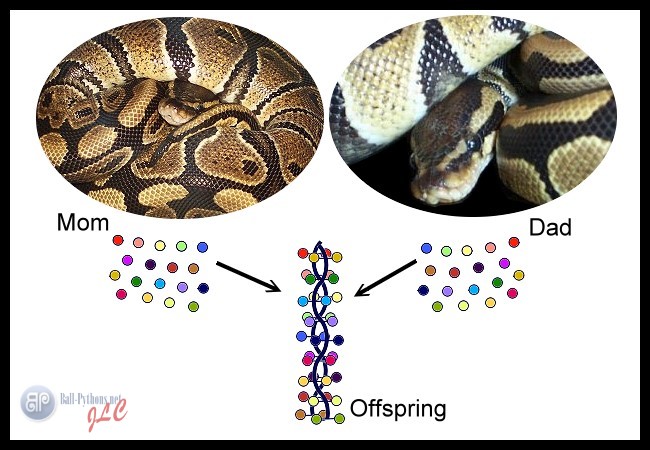
Most of the time, enough of these genes match up in such a way as to create what we call a “normal” or “wild type” appearance. Even within this “normal” range, there are so many different genes at work, and in so many different combinations, that the appearance of the animals will always have some variance…especially in a species like the ball python. There are many different looks that are all considered “normal.” For the purposes of this study, which is meant to lead to an understanding of breeding for various ball python morphs, let’s say that animals are considered “normal” because they’re specific genetic makeup is not only common, but is also too complicated and unpredictable to reproduce any single trait (such as lots of spots or a lack of spots) with any degree of certainty. Any visible trait that can be consistently and predictably reproduced is called “genetic” and the animals with these specific genetic traits are referred to as “morphs”.
WHAT MAKES A MORPH?
Occasionally, a single gene (or gene pair) will mutate outside of the normal variant range. This will cause the animal to look different from its normal peers and they will be called “morphs.” Some examples of this are Albinos, Axanthics, Spiders, and Pastels.
Different types of gene mutations will behave or affect the animal differently.
Many morphs are Recessive, which means they must have a matched gene pair in order to make a visual difference in the animal. Albinos, Axanthics, and Piebalds (Pieds) are examples of Recessive morphs.
And many other morphs are Dominant or Co-dominant, which means you can see a different look with just a single gene being represented.
What’s the difference between Dominant and Co-dominant?
A Dominant gene will produce the same look in the animal whether it is a single gene or a matched pair. Spiders and Pinstripes are examples of this type of morph.
A Co-dominant gene will produce one look when a single mutated gene is present and an entirely different look if there is a matched pair of the mutation. Pastels and Mojaves are examples of this.
So what happens when I breed XXX to xxx?
Let’s start with Recessives.
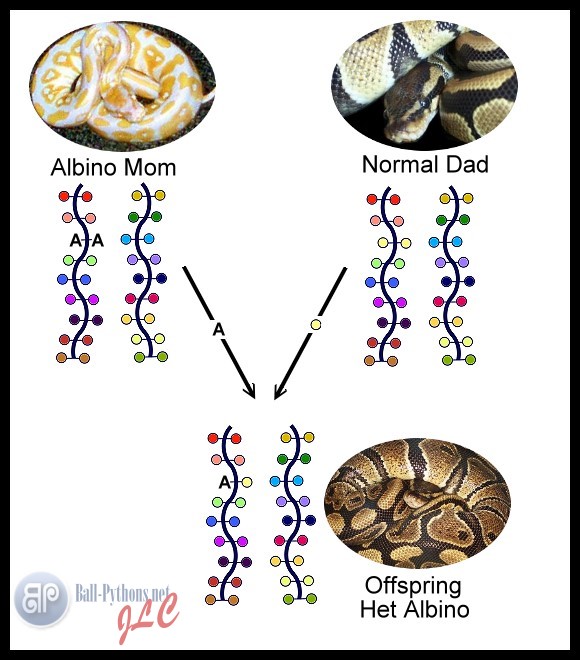
Notice the genetic chain for our Albino Mom. Instead of the yellow dots that a normal might have, she has a pair of A’s. The Dad is normal, so he just has yellow dots. Each parent contributes one gene from that allele to their offspring, and as you can see, the offspring has one A and one yellow dot. Because the Albino trait is recessive, it won’t show through the yellow dot on the other side and the baby looks normal. But she IS carrying an albino gene. (She is Het for Albino.) And she has a 50/50 chance of passing that gene on to her own offspring as well. (Each baby she produces will either get the A or the yellow dot.) If she is mated to another snake that also carries at least one albino gene, then there is a chance one of their babies will inherit an A on both sides of the “shoe string” and display the bright yellow and white traits of an albino ball python.
The following graphics show the potential offspring of a Het Albino with another Het Albino, and a Het Albino with an Albino mate.
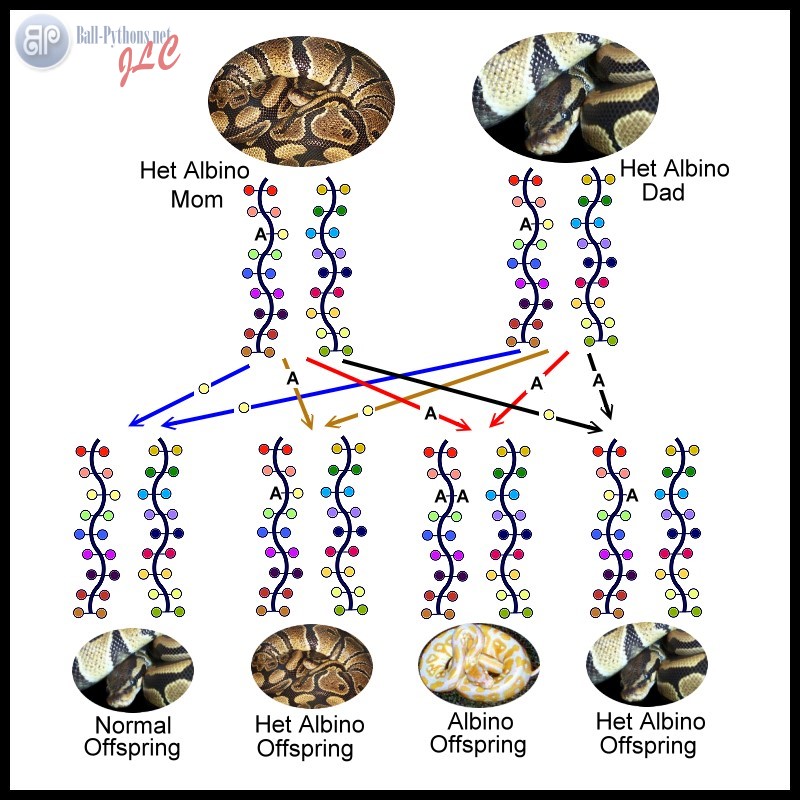
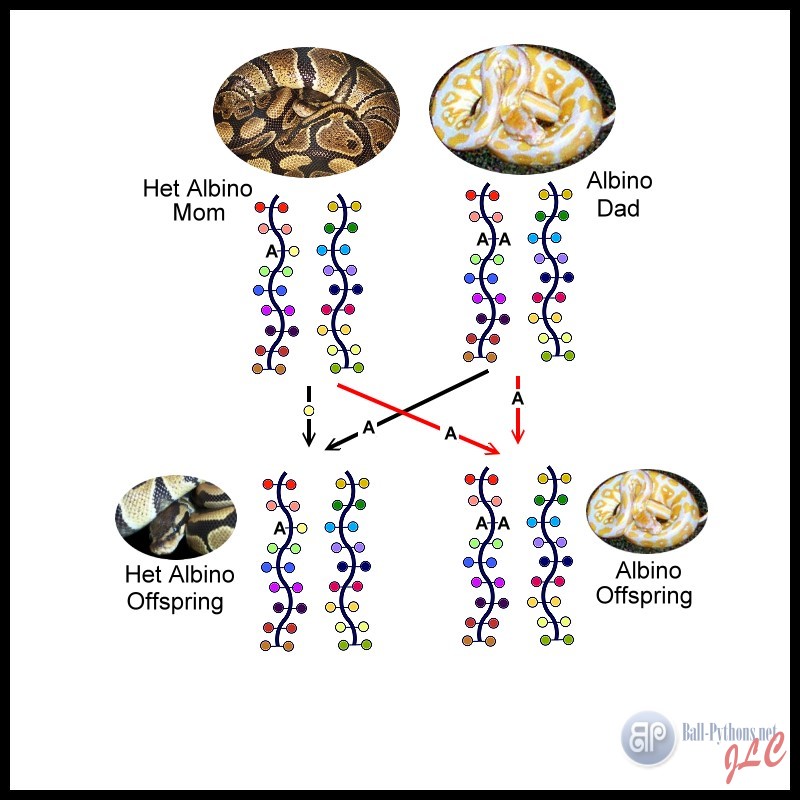
What about all those %’s people talk about?
When dealing with Het x Normal and Het x Het breeding pairs, all the Normal-looking offspring have a chance of being Het, but you can’t tell by looking whether or not it has the gene. In a Het x Normal pairing…each offspring has a statistical 50% chance of carrying the gene, so it is called “50% Het”. In a Het x Het pairing, all normal babies have a 66% chance of carrying the recessive gene and that’s where the “66% Het” term comes from.
Once one of these Possible Het animals mates with another carrying the same gene and produces visible morph offspring, they are considered “Proven” and are no longer referred to as “possible” or by any percentages. (Except maybe 100%. ;-) )
People sometimes use the term “100% Het” to refer to an animal that is an offspring of a visible morph because it is 100% certain that one copy of the recessive gene was passed on.
A Look at Dominant and Co-Dominant
With the Dominant morphs, it only takes one copy of the mutated gene to create a visual affect. With no known difference for having two copies. (Except that with a true homozygous form of a dominant morph, all the offspring would be guaranteed to carry the trait.)
Note the “S” represents the mutated gene that gives us the Spider morph, while a normal would have a light blue dot.
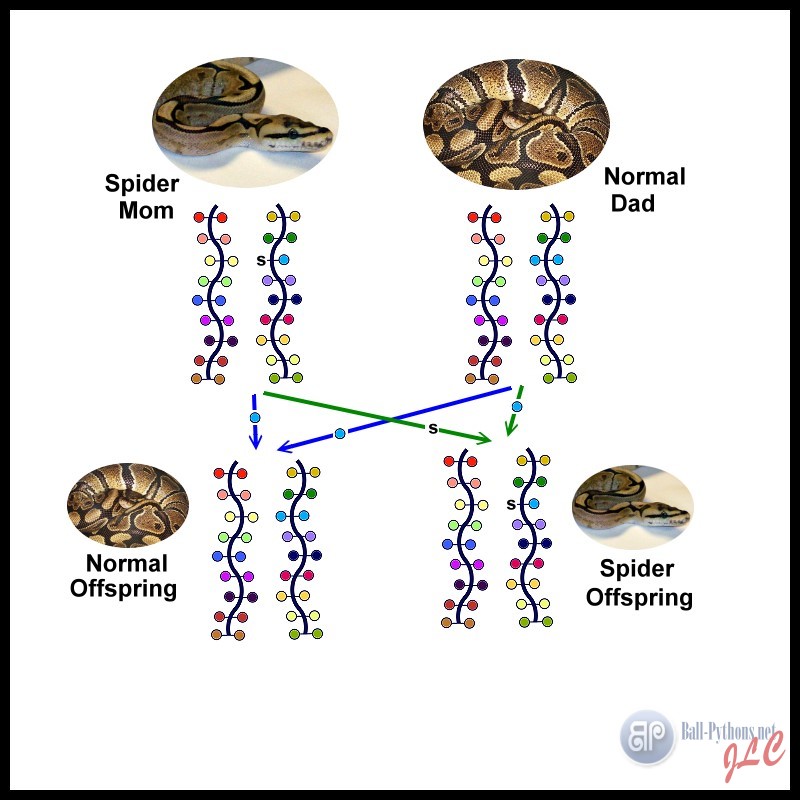
And here, we have the potential offspring of a Spider x Spider pairing. I have used “???” in place of an image for the “Homozygous Spider” because, as of my understanding at this time, no one has offered proof of their existence. Speculation is that a homozygous form would look no different than a spider with a single mutated gene. Therefore, it would be impossible to determine if a spider were “super” until it had produced several clutches of entirely spider offspring. But there is also speculation that when that mutated gene is paired with a matching one, the results are fatal, and therefore, no “super spiders” have survived incubation.
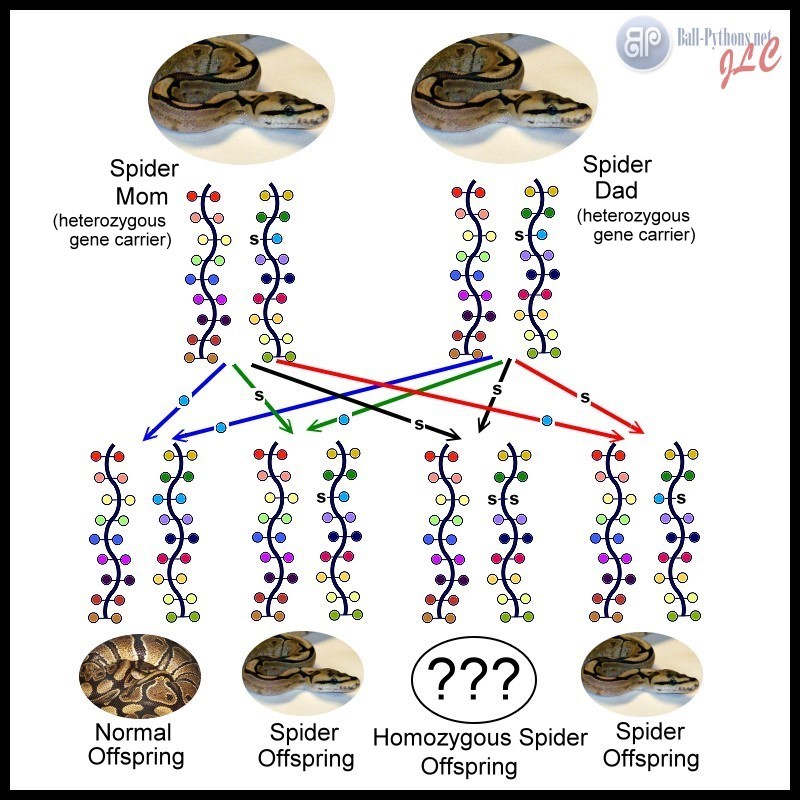
And now we’ll take a look at Co-Dominant morphs.
There are many co-dominant morphs, but our example here will be using the “Yellow Belly” and “Ivory” morphs. While the differences from a Normal can be subtle, the Yellow Belly (YB) has distinct characteristics that can be consistently recognized and passed on to offspring. When the snake is carrying a single mutated gene on this particular allele, it is called Yellow Belly or Het Ivory. When both copies of the mutated gene are present, the animal is called an Ivory and has a completely different look from its Het form.
These next two graphics show what you can get when you mate a YB to a Normal and a YB to another YB. Here, the mutated gene is represented by a Y and the normal gene by a blue dot.
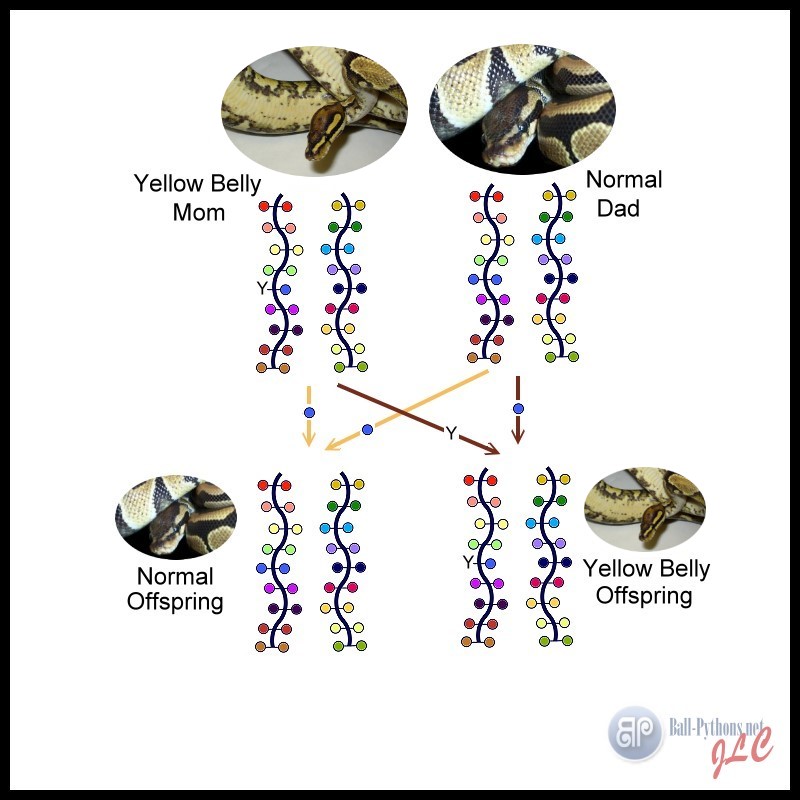

If you mate a Yellow Belly to an Ivory, all the babies will be either YB or Ivory. And two Ivories will give you all Ivories.
So how do you know if a morph is Recessive or Dominant or what?
It’s basically just a learning curve you have to get yourself over. Here are some lists of basic morphs and which category they fall into. It is far from exhaustive.
RECESSIVE:
Albino
Axanthic
Caramel Albino
Clown
Genetic Stripe
Ghost (Hypo)
Lavender Albino
Piebald (Pied)
DOMINANT:
Pinstripe
Spider
CO-DOMINANT:
Butter – Blue Eyed Leucistic
Cinny – Super Cinny
Enchi – Super Enchi
Fire Ball – Black Eyed Leucistic
Lesser – Blue Eyed Leucistic
Mojave – Blue Eyed Leucistic
Pastel – Super Pastel
Yellow Belly – Ivory
This has been a very basic and simple overview of Ball Python genetics. If one wants to dig deeper, one can begin to look into combo-morphs, where multiple gene pairings are being manipulated. There are also morphs out there being worked with whose genetics are not yet fully understood with “hidden genes” and other mysteries. There are sometimes combinations of morphs that seem to go against these basic rules, such as a Het Axanthic causing a visual difference when combined with a Pastel. There are issues of “compatibility” to be aware of, and different “lines” of morphs. Sometimes the same morph will have different names. There is much to learn and absorb and it should be seen as an exciting challenge to work on for the rest of your life!
LEARN MORE:
Markus Jayne's Genetics
Ralph Davis' Morph Matrix
NERD's Ball Python Morph Gallery
BP.net's Morph FAQs
Punnett Square Calculator
____________________
Authored by JLC of Ball-Pythons.net
Last edited by PitOnTheProwl; 10-21-2016 at 11:32 PM.
Reason: Removed T.H. link/post: 45744-quot-HUNTERS-GUIDE-TO-THE-MORPHS-quot-a-series-that-will-help-you-define-what-makes-a-morph
-
The Following 24 Users Say Thank You to JLC For This Useful Post:
- + Show/Hide list of the thanked
-
bcr229 (04-25-2013),BP Newbie (09-14-2012),Capray (09-12-2012),ChelseyDgaf (11-06-2015),Chrishimself0 (10-22-2012),cmack91 (10-04-2011),dchapman10 (07-16-2012),Dragon Rider (12-27-2011),eisenberg (03-14-2013),Flutteryng (04-22-2012),GpBp (10-10-2017),Herpking (09-17-2011),inca-kola (10-02-2018),Jeremy fine (08-30-2012),kenmalarik (12-14-2015),Kesp (04-24-2023),loganhub (03-27-2012),mrray13 (12-04-2022),Shayne (12-21-2018),Sirus Uno (07-16-2018),Solidus106 (02-15-2014),SteelPython (04-05-2015),Stephanie01 (01-27-2013),xxsarahxx (07-05-2016)
 Posting Permissions
Posting Permissions
- You may not post new threads
- You may not post replies
- You may not post attachments
- You may not edit your posts
-
Forum Rules
|


















 Reply With Quote
Reply With Quote